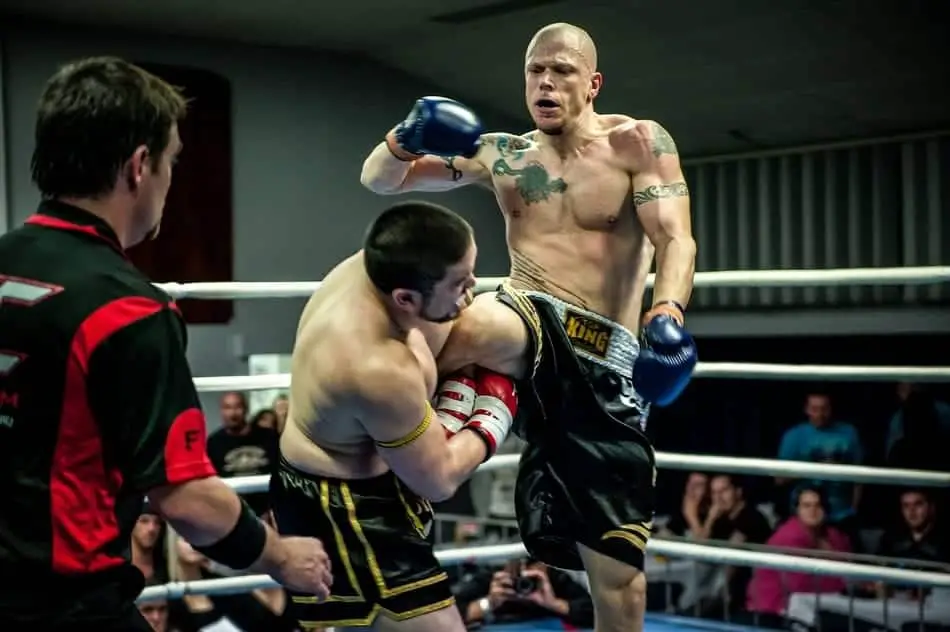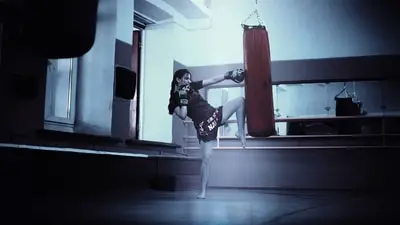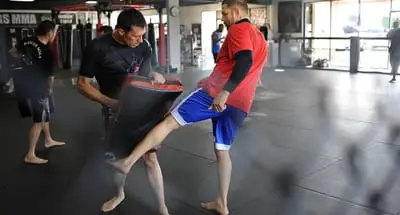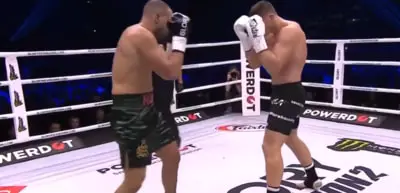
Kickboxers are pretty tall. That’s because tall people have naturally longer arm and leg reaches than short people which gives them an advantage in the ring. But how exactly tall are kickboxers? If you are wondering the same questions you came to the right place. In this article, I put together a list with the average height of the current top 10 kickboxers (according to combatpress.com) in each weight class:
- Heavyweight (209+ pounds): 6’5″ (195.7 cm)
- Light Heavyweight (up to 209 pounds): 6’2 1/2″ (189.8 cm)
- Middleweight (up to 187 pounds): 6’2 1/4″ (188.6 cm)
- Welterweight (up to 176 pounds): 5’11 3/4″ (182.8 cm)
- Lightweight (up to 160 pounds): 5’9 3/4″ (177.5 cm)
- Featherweight (up to 154 pounds): 5’8 1/4″ (173.8 cm)
- Bantamweight (up to 143 pounds): 5’8 1/4″ (173.9 cm)
- Flyweight (up to 132 pounds): 5’7 1/4″ (171 cm)
- Strawweight (up to 127 pounds): 5’6 1/2″ (169 cm)
The tallest top 10 kickboxer right now is the heavyweight Jamal Ben Saddik – 6’9 and the shortest is the flyweight Tenshin Nasukawa – 5’5.
As I already mentioned, kickboxers are very tall. On average kickboxers are slightly taller than boxers in the respective weight classes.
I think this is due to the longer leg reach kickboxers have. When you are just boxing, only your arm span (reach) is important. But that is not the case when it comes to kicking – the leg length is also important. So in boxing, you can have short legs for your height and still have a good reach if your arm span is good for your height.
Continue reading to learn more about why the height is so important in kickboxing, how your height determines your fighting style and how short kickboxers overcome their disadvantage.
Why is height so important?
The height itself isn’t enough. You also need to have a long reach. Often people say that the Range = Height + Reach. Ideally, to use the maximum range of your punches, your shoulders should be at the same level as your opponent’s face. That way your punches will travel in a straight line when hitting him, you won’t be punching down or punching up. And as we know, the shortest path between two points is the straight line. So besides the maximum range, your punches also will get to your opponent’s face the fastest way possible.
That’s why taller kickboxers are usually rangier. They can kick and punch from a distance from where a shorter kickboxer can’t touch them. They usually use techniques such as jabs, straight punches, long knees, teeps, and high kicks.
They like to control the distance using those rangy techniques. For defense, they lean back, use long guard (if they have Muay Thai background) to parry punches, and of course blocking. For kicking often defense they like to pull their leg back instead of checking and come back with punches.
All these are great techniques that help you out-land the opponent and win the fight on points even if you don’t get the finish.
Tall kickboxers often fight off the back foot and they prefer to be in the center of the ring (while their shorter opponents try to pressure them to the ropes).
Your Fighting Style Depends on your Height
The way you fight (your style) depends on the height difference between you and your opponent. You can see someone fighting like a tall fighter – using straight punches, teeps and keeping a distance when fighting a shorter opponent. And when fighting someone taller than him, the same person may pressure his opponent, always try to close the distance, work the body, etc. Which is the opposite of how tall kickboxers fight. That’s why your style must be determined by your opponent if you want to win.
When someone is rangier than you, you can’t fight him from the outside (from a long-distance). You must try to pressure him, try to get him on the ropes where he can’t keep that distance.
That can be a real problem for some people. For example, I’m a tall and lanky guy and I like to fight from a distance and tie-up if my opponent manages to get too close to me. But it’s very hard for me when I spar with someone taller. I’m not that used to pressure people and keep a high guard. Also, I can keep a distance and fight off the back foot all day long but when I have to pressure my opponent I gass out pretty quickly – probably because I’m not used to doing that.
Point Fighting
One of the problems tall kickboxers have is that they are often point fighting. That means that they get mostly decisions and not much finishes. Don’t get me wrong there are tall fighters who are great finishers (for example Badr Hari). But most of the time when you try to keep a distance, you can easily win on points without risking getting clipped when trying to finish your opponent.
Also if you are very tall, you’ll probably be skinny in order to make the weight to compete in your weight class (except if you are a heavyweight). And most skinny kickboxers don’t have knockout power. They still punch hard and can knock you out but that usually happens with flurries of punches and not by one shot and when their opponent is tired in the later rounds.
That itself isn’t a problem because you still win the fights with decisions. The problem is that many people don’t find such a style attractive especially casual fans. They want to see knockouts, brawling etc. And this is a problem because the more famous you are the more opportunities and money you get.
That’s why for example Mike Tyson is probably the most famous boxer (or the second one after Ali) while he hasn’t fought the best competition – mostly not that great boxers or great boxers but out of their prime. But regardless of that, many people think he is the best boxer.
Now, there are really boring fighters, for example, those who are always clinching. But most of the technical tall kickboxers are actually really fun to watch no matter that they don’t always get the finish.
How the Short Kickboxers can Overcome their Disadvantage?
A tall technical fighter who knows how to use his reach and has a good defense is extremely hard to beat. For example, in boxing, such a fighter -Wladimir Klitschko holds the record for the longest cumulative heavyweight title reign. And his style was only keeping a distance, throwing a lot of jabs, occasionally right straights after the jab and lunging left hooks if the right hands aren’t landing.
When his opponent managed to close the distance he just tried to clinch by head locking them with his lead arm. Needless to say, that wasn’t the most entertaining style but it was very very effective.
In kickboxing, short fighters have the leg kicks as a weapon against their taller opponents. Sometimes taller kickboxers stay a little sideways so they can use the maximum reach of their lead hand and lead leg. But that makes them vulnerable to leg kicks from the outside.
Also, short kickboxers can use inside low kicks (when fighting orthodox stance vs orthodox stance) to set up their punches and close the distance.
Another good weapon against someone taller than you is overhand – that is a punch specifically designed for fighting taller people.
The main problem short kickboxers have is closing the distance. They can do that with inside low kicks as I already mentioned or with double jabs while moving forward.
When they close that gap, they can unleash punching combinations to the body and the head (hooks and uppercuts) and finish the combination with a powerful rear low kick.
The main goals for short kickboxers in order to win must be to closing the distance, pressuring their opponent in the ropes and generally making the fight chaotic and ugly (instead of rangy and technical).



